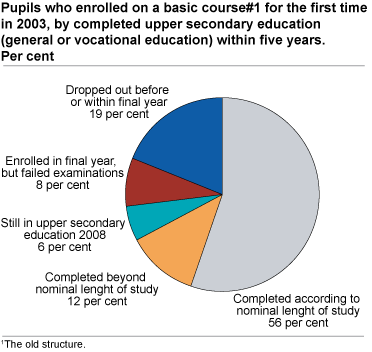Content
Published:
This is an archived release.
Starts in vocational studies, general education completions
One out of four who enrolled in vocational studies in upper secondary education autumn 2003 obtained general education within five years. Grades from primary school are of great importance for the results of throughput of pupils.
A total of 54 per cent of the pupils who enrolled in basic courses in upper secondary in autumn 2003 started up in vocational studies. About 33 per cent of these pupils completed their vocational education, while 23 per cent completed a general education. A total of 45 per cent of the pupils in vocational studies did not complete their education within five years.
A large proportion of pupils who enrolled in general studies completed upper secondary education. A total of 26 000 pupils started their education in general areas of study. Eight out of ten completed within five years.
Small difference between cohorts
The proportion of pupils and apprentices who complete general or vocational education within five years is, as in previous years, stable at about 70 per cent. In the 2003 cohort, nearly 50 per cent completed a general education, while 18 per cent completed a vocational education.
Coherence between lower secondary school points and results of throughput of pupils
Lower secondary school points:Lower secondary school points sum up the pupils’ results in different subjects, and form the basis of entrance/intake in upper secondary education. Including school year 2005/2006, the lower secondary school points were calculated by adding up the numerical value of eleven grades of subjects. |
Nine out of ten with the highest sum of lower secondary school points (55-66 points) that enrolled in upper secondary education 2003, completed according to the normative length of study. Almost all of these pupils/apprentices completed their education within five years. Just half of the pupils or less, with fewer than 40 lower secondary school points, completed a general or vocational education.
Differences in areas of study
Lower secondary school points are of importance for the result of throughput of pupils. Among pupils with the best results from lower secondary school, a large proportion completed upper secondary education within five years in general areas of study, compared to vocational studies. Compared to the pupils with a lower number of points (25-34), the proportion of pupils who completed upper secondary education was 4-6 percentage points higher in vocational studies than in general areas of study.
Tables:
- Table 1 Pupils who started a basic course for the first time in 1994, 1998, 2000, 2001, 2002 and 2003, by completed upper secondary education whithin five years, and gender. Per cent
- Table 2 Pupils who started a basic course for the first time in 2003, by completed upper secondary education within five years, areas of study and gender. Per cent
- Table 3 Pupils who started a basic course for the first time in 2003, by completed upper secondary education within five years, gender and parents' level of education. Per cent
- Table 4 Pupils and who started a basic course for the first time in 2003, by completed upper secondary education within five years, gender and county of residence at 16 years of age. Per cent
- Table 5 Immigrants and Norwegian-born to immigrant parents who started a basic course for the first time in 2003 by completed upper secondary education within five years, gender and country background. Per cent
- Table 6 Pupils who started a basic course for the first time in 2003, by completed upper secondary education whitin five years, by areas of study and final qualification.Per cent
- Table 7 Pupils who started a basic course for the firste time in 2003, by completed upper secondary education within five years, lower secondary school points and gender. Per cent
- Table 8 Pupils who started a basic course for the first time in 2003, by completed upper secondary education within five years, lower secondary school points and areas of study. Per cent
Additional information
Statistics follow an intake of pupils through a five-year period in upper secondary education.

